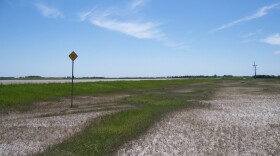Are you familiar with bittersweet (Celastrus scandens)? It is a woody vine that can be found twining up trees and shrubs in woodlands and groves throughout North Dakota. It seems to go largely unnoticed during the summer months because it is buried in with the other green foliage. And there is not much that would catch your eye. But this time of year, particularly once the leaves have fallen, the bright orange fruits are much easier to spot.
Depending on where you live, the leaves of bittersweet may have fallen, if not, this time of year they will be a pale yellow, with perhaps a hint of green. The color is quite distinctive, and because the bittersweet vine typically climbs tall shrubs or trees, the foliage often has a noticeably vertical or cascading orientation.
Bittersweet is rather unusual in that it has separate male and female plants (dioecious). If you happen to see a female plant this time of year, the bright yellow-orange fruits, which are about one-half inch in diameter, are quite showy. Upon maturity, the fruits split open in four orange segments revealing a bright red seed (actually several seeds). They are really quite attractive. The branches with fruits are occasionally cut for use in fall arrangements. The fruits are poisonous to humans but are eaten by a variety of birds and small mammals.
Bittersweet is occasionally used as an ornamental. It can be propagated by stem or root cuttings, or from seed planted as soon as ripe, or perhaps the following spring following stratification or cold treatment. If you ever consider planting some bittersweet, be sure to plant several of them because you need to have at least a few male plants as well as female plants to ensure the female plants can produce the bright display of fruits during fall. And of course, be careful as to what they will climb, because bittersweet can be damaging or even kill a supporting tree.
So be on the lookout for some clusters of small red fruits high among the trees as you travel about this fall and into winter. You may discover there is more bittersweet around your area than you may have thought.





